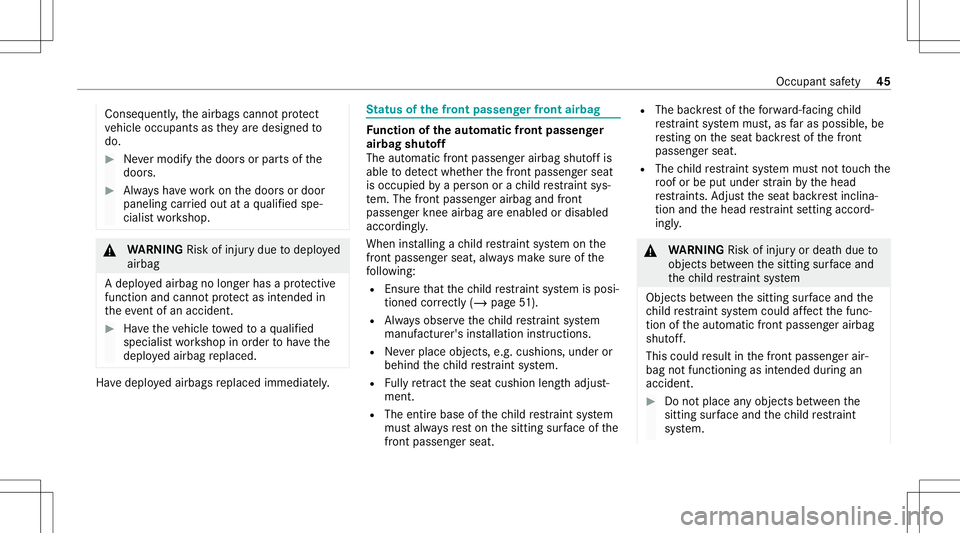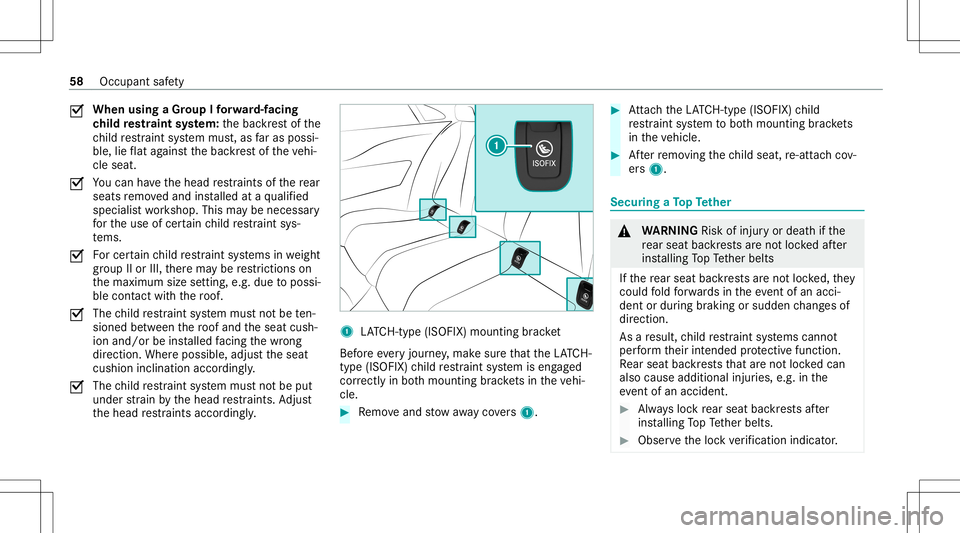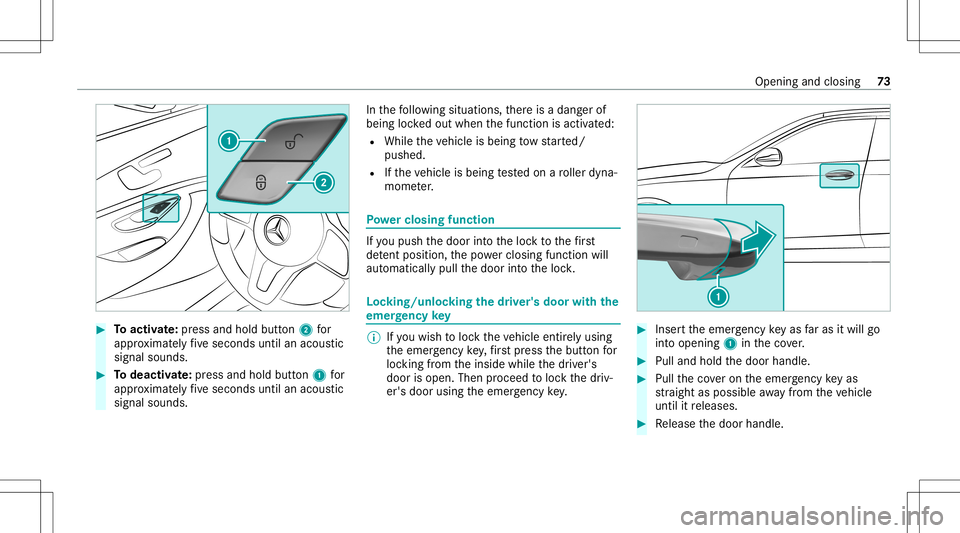2020 MERCEDES-BENZ E-CLASS COUPE tow
[x] Cancel search: towPage 47 of 550

Con
sequen tly, theairbags cannotprotect
ve hicle occupants asthey aredesig nedto
do. #
Nevermodify thedoor sor par tsof the
door s. #
Alw aysha ve wo rkon thedoor sor door
paneling carried out ataqu alif ied spe‐
cialis two rkshop. &
WARNIN GRisk ofinju rydue todeplo yed
airbag
A deplo yedairbag nolong erhas apr otect ive
func tion andcann otprotect asintended in
th eev ent ofan acciden t. #
Have theve hicle towe dto aqu alif ied
spec ialistwo rkshop inorder tohave the
deplo yedairbag replaced. Ha
ve deplo yedairbags replaced immediat ely. St
atus ofthefront passeng erfront airbag Fu
nction oftheaut oma ticfront passeng er
air bag shutoff
The automatic front passeng erairbag shutoffis
able todetect whe ther thefront passeng erseat
is occupied byaper son orach ild restra int sys‐
te m. The front pass engerairb agand front
pass engerknee airbagareenabl edordisa bled
accor dingly.
When installing ach ild restra int system onthe
fr ont passeng ersea t,alw aysmak esur eof the
fo llo wing:
R Ensur eth at thech ild restra int system isposi‐
tion edcor rectl y(/ page 51).
R Alw aysobser vethech ild restra int system
manuf acturer'sinstallation instruct ions .
R Neverpla ceobjects, e.g.cushi ons,under or
behi ndthech ild restra int system.
R Fully re tract theseat cushion lengthadjus t‐
ment .
R The entire base ofthech ild restra int system
mus talw aysre st on thesitt ing surface ofthe
fr ont passeng ersea t. R
The backres tof thefo rw ard-f acin gch ild
re stra int system mus t,as faras possi ble,be
re sting ontheseat backres tof thefront
passeng erseat.
R The child restra int system mus tno tto uc hth e
ro of or be put under stra in by thehead
re stra int s.Ad jus tth eseat backres tinclin a‐
tion andthehead restra int setting accord‐
ing ly. &
WARNIN GRisk ofinju ryor deat hdue to
object sbe tween thesitt ing surface and
th ech ild restra int system
Objec tsbetween thesitt ing surface and the
ch ild restra int system could affect thefunc ‐
tion oftheaut omatic front passeng erairbag
shut off.
This could result inthefront passeng erair‐
bag notfunc tioningasintended during an
acciden t. #
Donotplace anyobjec tsbetween the
sitting surface and thech ild restra int
sy stem. Occ
upant safety 45
Page 52 of 550

R
Vehicl eswith sliding sunroof:Clo sethe
sliding sunroof.
R Vehicl eswith memor yfuncti on:Movethe
fr ont passeng ersea tto amor efa vo rable
seat position .
R Vehicl eswith multico ntour seat :Incr ease
th eair pressur ein theseat sidebolsters of
th eseat backres t.
R PRE-S AFE®
Sound: prov ided that themulti‐
media system isswitc hedon,gener ates a
br iefnoi sesigna lto stimulat eth einnat epr o‐
te ctiv emec hanism ofaper son's hearing.
* NO
TEDama gecau sed byobject sin the
fo ot we llor behin dth eseat The
automatic adjustmentof theseat posi‐
tion mayre sult indamag eto theseat and/or
th eobjec t. #
Stow object sin asuit able place. Re
versing thePRE- SAFE®
sy stem mea sures If
an acc iden tdid notocc ur,th epr e-em ptive
measur esthat we retake nar ere ve rsed.
Yo uwill need toper form certainse ttings your‐
self . #
Ifth eseat beltpre-t ension ingisno tre duced,
mo vetheseat backres tbac kslightl y.
The locking mechanism releases. Fu
nction ofPRE-S AFE®
PL US (anticipat ory
occupant protection plus) PRE-
SAFE®
PL US can detect cer tain im pact s,
par ticular lyan imm inentrear impact ,and take
pr e-em ptive measur estoprotect theve hicle
occupants. Thesemeasur escanno tnecessar ily
pr eve ntan imm inentimpact.
PR E-S AFE ®
PL US can implem entthefo llo wing
measur esindepe ndently of eac hot her :
R Tight ening theseat belts onthedr iver's seat
and front passeng erseat.
R Increasin gbr ak epr essur ewhen theve hicle
is statio nary.This brak eapplication iscan‐ celed
automaticall ywhen theve hicle pulls
aw ay.
If an accident didnotoccur ,th epr e-em ptive
measur esthat we retake nar ere ve rsed.
Sy stem limit s
The system will notinitiat ean yaction inthefo l‐
lo wing situat ions:
R when backingup
The system will notinitiat ean ybr aking applica‐
tion inthefo llo wing situat ions:
R whils tdr ivin g
or
R when entering orexitin gapar kingspace
while using ActivePa rking Assist 50
Occupant safety
Page 60 of 550

0073
When
usingaGr oup Ifo rw ard-f acin g
ch ild restra int system: thebac kres tof the
ch ild restra int system mus t,as faras possi ‐
ble, lieflat agains tth ebac kres tof theve hi‐
cle seat.
0073 Yo
ucan have thehead restra int sof there ar
seat sre mo vedand installed ataqu alif ied
spec ialistwo rkshop. Thismaybe necessar y
fo rth euse ofcer tain child restra int sys‐
te ms.
0073 Fo
rcer tain child restra int systems inwe ight
gr oup IIor III,th er ema ybe restrictions on
th emaximum sizesetting, e.g. due topossi‐
ble con tact with thero of.
0073 The
child restra int system mus tno tbe ten‐
si oned betwee nth ero of and theseat cush‐
ion and/or beinstalled facing thewr ong
dir ect ion. Wher epossible, adjustth eseat
cushion inclination accordingly.
0073 The
child restra int system mus tno tbe put
under stra in by thehead restra int s.Ad jus t
th ehead restra int sacc ording ly. 1
LATC H-type (ISOFIX )mou nting brac ket
Bef oreev eryjour ney,mak esur eth at theLA TC H-
type (ISOFIX )ch ild restra int system iseng aged
cor rectl yin bo th mounting brac kets intheve hi‐
cle. #
Remo veand stow away covers 1 . #
Attach theLA TC H-type (ISOFIX )ch ild
re stra int system toboth mounting brac kets
in theve hicle. #
Afterre mo ving thech ild seat, re-att achco v‐
er s1. Se
cur ingaTo pTe ther &
WARNIN GRisk ofinju ryor deat hif th e
re ar seat backres ts areno tloc kedaf te r
ins talling TopTe ther belts
If th ere ar seat backres ts areno tloc ked, they
cou ldfold forw ards intheeve ntofan acci ‐
de nt or during braki ng orsudd en chang esof
dir ect ion.
As are sult, child restra int systems cann ot
per form their intended protect ive func tion.
Re ar seat backres ts that areno tloc kedcan
also cause additional injuries, e.g. inthe
ev ent ofan acciden t. #
Alw aysloc kre ar seat backres ts afte r
ins talling TopTe ther belts. #
Obser vetheloc kve rificati onindi cator. 58
Occup antsafety
Page 75 of 550

#
Toactiv ate: press and hold button2 for
appr oximat elyfive seconds untilanacous tic
signal sounds. #
Todeac tivate: press and holdbu tton 1 for
appr oximat elyfive seconds untilanacous tic
signal sounds. In
thefo llo wing situat ions,th er eis adang erof
being lockedout when thefunc tion isactiv ated:
R While theve hicle isbeing tow star ted/
pushed.
R Ifth eve hicle isbeing tested on aro ller dyna‐
mome ter. Po
we rcl os ingfun ction If
yo upush thedoor intoth eloc kto thefirs t
de tent positio n,thepo we rclosi ngfunction will
au tomatical lypul lth edoor intoth eloc k. Loc
king/u nlocking thedr iver' sdoor withth e
emer gency key %
Ifyo uwish toloc kth eve hicle entirelyusing
th eemer gency key,firs tpr es sth ebutt onfor
loc kin gfrom theinside whilethedr iver's
door isopen. Thenproceed toloc kth edr iv‐
er's door using theemer gency key. #
Inser tth eemer gency keyas faras itwil lgo
int oopening 1intheco ver. #
Pull and hold thedoor handle. #
Pull theco veron theemer gency keyas
st ra ight aspossible away from theve hicle
until itre leases. #
Release thedoor handle. Openin
gand closing 73
Page 80 of 550

When
making thekic king movement, makesur e
th at your feet arefirm lyon thegr ound, other‐
wise youco uld lose your balan ce,e.g.on ice.
Obs erve thefo llo wing notes:
R The Smar tKey isbehin dth eve hicle.
R Stand atleas t12 in(30 cm) away from the
ve hicle while perform ing thekic king move‐
ment.
R Donotcome intocont actwithth ebum per
while making thekic king movement.
R Donotcar ryout thekic king movement too
slo wly.
R The kicking movement mustbe towa rdsth e
ve hicle andbackag ain. 1
Detection rang eof thesensor s
If se veralcon secut ive kic kin gmo vements are
no tsuccessfu l,wa itte nseco nds.
Sy stem limit s
The system maybe impair edorma yno tfunc tion
in thefo llo wing cases :
R The area around thesensor isdir ty,e.g. due
to road salt orsnow .
R The kicking movement ismade using apr os‐
th etic leg. The
trunk lidcould beopen edorclos edunin ten‐
tio nal ly,in thefo llo wing situat ions:
R Ifaper son 'sarms orlegs aremo vingin the
sensor detection rang e, e.g .wh en polishi ng
th eve hicle orpic king upobject s.
R Ifobject sar emo vedor placed behind the
ve hicle, e.g.tensi oni ng stra ps orlugg age.
R Ifclam ping stra ps, tarp sor other coverings
ar epu lled ove rth ebum per.
R Ifapr otect ive mat withalengt hre ac hin g
ov er thetrunk silldown intoth ede tection
ra ng eof thesensor sis used.
R Ifth epr otect ive mat isno tsecur edcor rectly .
R Whe nwo rking onthetra iler hitch,tra iler sor
re ar bicy clerack s.
Deactiv ateKEYLES S-GO(/page66) ordo not
car rytheSmar tKey about your per son insuc h
sit uatio ns. Swit
ching separ atetrunk locking onoroff If
yo ucen trall yunlo cktheve hicle while separate
loc king isactiv ated, thetrunk willremain locked. 78
Opening andclosing
Page 92 of 550

R
Afterpr essing thest ar t/ stop butt onwithth e
Smar tKey inthestow agecom partment
(/ page14 4)
% When theMer cedes‑ Benzemergency call
sy stem isactiv eand thealar mstay son for
mor eth an 30 sec onds, ames sageis aut o‐
mat icall ysen tto theCus tomer Assis tance
Ce nter (/ page 328) .
% Inthecase ofsevere batt erydisc harging,
th eanti- theftalar msystem isaut omaticall y
deactiv ated tofacil itat eth ene xt engine
st ar t.
Deact ivat ing theATA #
Press theÜ, ßor008B buttononthe
Smar tKey .
or #
Press thest ar t/ stop butt onwithth eSmar t‐
Ke yin themar kedspace (/page14 4)
Dea ctivat ingth eala rm using KEYLESS-GO #
Grasp theoutside doorhandle withth e
Smar tKey outside theve hicle. Fu
nction oftheto w- aw ay alar m %
This function mayno tbe available inall
coun tries.
An audible andvisual alarmistrigg ered ifan
alt eratio nto your vehicle's angleof inclination is
de tected whi letheto w- aw ay alar misarmed.
The tow- aw ay alar misaut omat icallyar med afte r
appr oximat ely60 seco nds:
R Afterloc king theve hicle withth eSmar tKey
R Afterloc king theve hicle using KEYLES S-GO
The tow- aw ay alar mison lyarmed when thefo l‐
lo wing compone ntsar eclos ed:
R The door s
R The trunk lid
The tow- aw ay alar misaut omat icallydeac tiva‐
te d:
R Afterpr essing theÜ or008B buttonon
th eSmar tKey
R Afterpr essing thest ar t/ stop butt onwithth e
Smar tKey inthemar kedspace (/page14 4) R
Afterunloc kingtheve hicle using KEYLES S-
GO
R When usingHAND S-FREE ACCES S
In fo rm atio non detecting damag eon apa rked
ve hicle (/page17 1). Ar
ming/ disarming theto w- aw ay alar m Mul
timedi asy stem:
4 Vehicle 5
î Vehicle Setting s
5 Tow-away Protection #
Activate0073 ordeacti vate 0053 thefunc tion.
The tow- aw ay alar misarmed again inthefo llo w‐
ing cases :
R The vehicle isunloc kedag ain.
R Adoor isopened.
R The vehicle isloc kedag ain. Fu
nction oftheint erior motion sensor %
This function mayno tbe available inall
coun tries. 90
Openingand closing
Page 93 of 550

When
theint erior motion sensor isactiv ated, a
visual andaudible alarmistrigg ered ifmo ve‐
ment isde tected intheve hicle interior .
The interior motion sensor isactiv ated aut omati‐
cally afte rapp roxima tely tenseco nds:
R afte rloc king theve hicle withth eSmar tKey
R afte rloc king theve hicle using KEYLES S-GO
The interior motion sensor isonl yactiv ated
when thefo llo wing compone ntsar eclos ed:
R thedoor s
R thetrunk lid
The interior motion sensor isaut omaticall ydeac‐
tiv ated:
R afte rpr essing theÜ or008B buttonon
th eSmar tKey
R afte rpr essing thest ar t/ stop butt onwithth e
Smar tKey inthestow agecom partment
(/ page14 4)
R afte runloc kingtheve hicle using KEYLES S-
GO
R when usingHAND S-FREE ACCES S The
follo wing situat ionscanlead toafa lse
alar m:
R movingobje ctssuc has masc otsin theve hi‐
cle interior
R when theside windo wisopen
R when thepanor amicsliding sunroofisopen Ac
tiv atin g/deac tivatin gthe inte rior mo tion
sensor Mult
imedia system:
4 Vehicle 5
î Vehicle Setting s
5 Interior Motion Sensor #
Activate0073 ordeacti vate 0053 thefunc tion.
The interior motion sensor isactiv ated again in
th efo llo wing cases :
R The vehicle isunloc kedag ain.
R Adoor isopened.
R The vehicle isloc kedag ain. Openin
gand closin g91
Page 94 of 550

No
teson thecor rect driver' sseat position &
WARNIN GRisk ofinju ryfrom adju sting
th eve hicle settin gswhile theve hicle isin
mo tion
Yo uco uld lose contro lof theve hicle inthe
fo llo wing situat ions:
R ifyo uadj ustth edr iver's seat, thehead
re stra int ,th esteer ing wheel orthemir ror
while theve hicle isin mo tion
R ifyo ufa sten your seat beltwhile theve hi‐
cle isin mo tion #
Beforest ar tin gth eengine: adjustth e
dr iver's seat, thehead restra int ,th e
st eer ing wheel orthemir rorand fasten
yo ur seat belt. En
sur eth efo llo wing when adjustingst eer ing
wheel 1,seat belt2and driver's seat 3:
R Youar esit tin gas faraw ay from thedr iver's
airbag aspossible, taking thefo llo wing
point sint ocon sider ation .
R Youar esit tin gin an upr ight position
R Your thighs areslight lysuppor tedby theseat
cushion R
Your legs areno tfull yex tende dand youcan
depr essthepedals proper ly
R The backof your head issuppo rted ateye
le ve lby thecent erofthehead restra int
R Youcan hold thesteer ing wheel withyo ur
ar ms sligh tly ben t
R Youcan moveyour legs freel y
R Youcan seeallthedispla yson theins tru‐
ment clusterclea rly
R Youha ve agood overvie wof thetra ffic con ‐
dition s
R Your seat beltsitssn ug lyag ains tyo ur body
and pass esacr oss thecent erofyour sho ul‐
der and across your hips inthepelvic area 92
Seats andstow ing